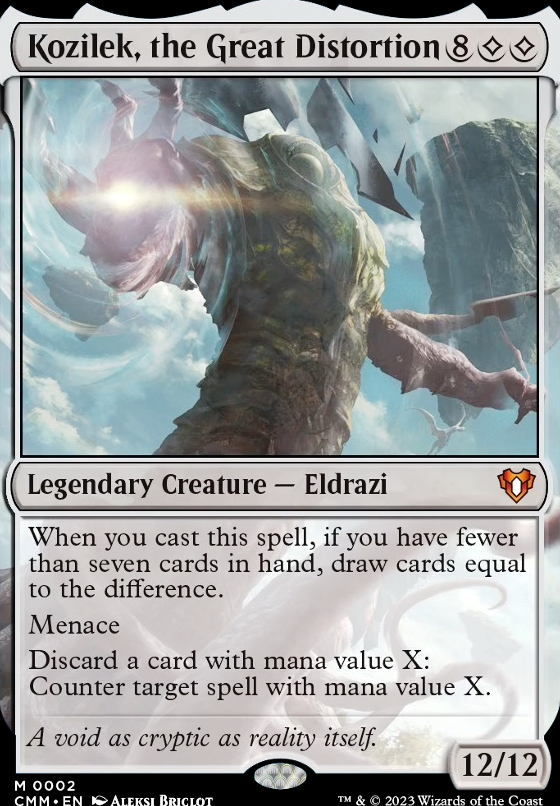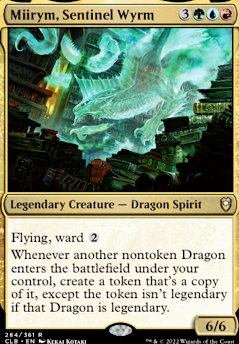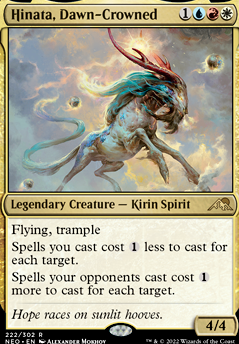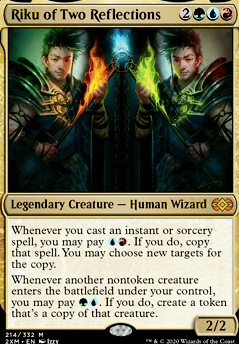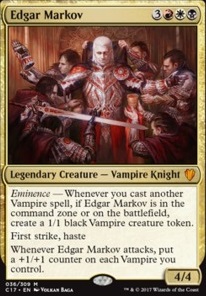Wastes: There are eight in the deck.
Reliquary Tower: Reliquary Tower is another version of Thought Vessel. It taps for and gives us no maximum hand size. I like cards in my hand. I don't like discarding cards if I have more than seven at the beginning of my end step. Reliquary Tower helps to make sure I don't have to.
Rogue's Passage: Rogue's Passage has political benefits, as the creature we target does not have to be under our control. Albeit useful, Rogue's Passage inclusion is not meant to just provide our opponents' creatures with unblockability. Kozilek, the Great Distortion has menace, which is good, but in our format there are a lot of creatures clogging up the battlefield that would be happy to trade their lives in order to prevent 12 points of General/Commander damage. Rogue's Passage ensures that attacking for General/Commander damage will not be a problem.
Endless Sands: Endless Sands has its benefits. If an opponent attempts to borrow one of our creatures for some maleficient purposes, we can activate Endless Sands to exile it. Is an opponent targeting one of our creatures with Anguished Unmaking or Path to Exile? Let's exile it with Endless Sands for the purposes of bringing it back in the future. If we tap and sacrifice Endless Sands, we can return each creature card exiled with Endless Sands to the battlefield under our control. Admittedly, this is a little pricier to pull off than simply using Safe Haven, but the ability to sacrifice Endless Sands at any time is strategically more favorable. REPLACED BY War Room ON 1/28/21. SEE YOUTUBE VIDEO BELOW FOR DISCUSSION (EPISODE 317, UP & UP SERIES INSTALLMENT #2).
Strip Mine: Maze of Ith. Unfortunately, Maze of Ith is a thing and so is Spires of Orazca
. Strip Mine's inclusion is to clear the path for our bigguns. Investing so much mana into one of our powerful creatures only to have an opponent tap a land to remove it from combat hurts. It hurts a lot. Strip Mine helps to ease the pain.
Inventors' Fair: Metalcraft ability #1 nets us one life at the beginning of our upkeep. This isn't terrible considering the low number of gain-life spells in our deck. Metalcraft ability #2 allows us to tap and sacrifice Inventors' Fair in order to search our library for an artifact card, reveal it, and put it into our hand. In a deck full of artifacts, Inventors' Fair acts as an artifact tutor if we meet its metalcraft requirements. #WeGotThisBro.
Scavenger Grounds: Graveyards in our format nowadays are simply additional hands. Every deck in EDH/Commander should have some forms of recursion in order to re-use resources. Scavenger Grounds is our global Tormod's Crypt in the form of a land. Honestly, Relic of Progenitus does it better by providing single card exile in addition to drawing us a card if we decide to exile everyone's 'yards. My reason for choosing Scavenger Grounds in this slot is its ability to provide mana. Maybe we're at the table with very little or no graveyard recursion, neutering the effectiveness of Relic of Progenitus. If so, then the debate is a card that draws a card vs. a land. I'd rather have the land.
Shrine of the Forsaken Gods: Shrine of the Forsaken Gods is a variation of Temple of the False God. With Shrine of the Forsaken Gods we can tap it for immediately and if we have at least seven lands it taps for . Temple of the False God will net us but we must control at least five lands in order to activate it. Either way, both lands are valuable in this deck as we want to generate a lot of colorless mana.
Field of Ruin: This is another land that will ensure a Maze of Ith-free battlefield. Field of Ruin replaces itself and the nonbasic land it destroys, but also allows other opponents to fetch-out a basic land. A free land. For nothing. Just for sitting at the table!! This is not optimal, and conflicts with one of my deck-building guidelines of not playing cards that can strengthen our opponents. This land is used with great caution, and its inclusion is necessary in order to clear a path to victory on the battlefield, absent any mazes.
Darksteel Citadel: This artifact land taps for and is indestructible. That is all.
Haven of the Spirit Dragon: The second ability of Haven of the Spirit Dragon is useless in this deck. Aside from this ability, it provides the typical in addition to allowing us to tap , sacrifice Haven of the Spirit Dragon and return a dragon creature card or a Ugin planeswalker card from our graveyard to our hand. Steel Hellkite, Ugin, the Ineffable and Ugin, the Spirit Dragon approve.
Eye of Ugin: Eye of Ugin does not tap for any mana, but it reduces the cost of our eldrazi spells by . Additionally, we can tap , tap Eye of Ugin and search our library for a colorless creature card, reveal it, and put it into our hand. Notice that the text does not say "colorless eldrazi creature card." We can tutor for artifact creatures as well. Notice that the text does not say "sacrifice Eye of Ugin." This is a repeatable ability.
Buried Ruin: Here is another form of graveyard recursion a la Haven of the Spirit Dragon, except the target is not as specific. Providing the requisite , Buried Ruin also allows us to tap , tap it, sacrifice it and return an artifact card from our graveyard to our hand. Our deck is filled with artifacts and, inevitably, some of them will be destroyed. Buried Ruin is included in this deck as a way to bring an artifact back.
Zhalfirin Void: When Zhalfirin Void enters the battlefield we can scry 1. This is simply a Wastes with a keyword. This makes Zhalfirin Void more valuable than a Wastes, explaining its inclusion in the deck. Other than that, it taps for . That is all.
High Market: The usual allotment in addition to life gain is not terrible, particularly in a deck with very few spells dedicated to swing our life total upwards. High Market allows us to protect our creatures from exile or from being absconded. A creature in the graveyard is better than a stolen or exiled exiled.
Radiant Fountain: When Radiant Fountain enters the battlefield, we gain two life. This is a Wastes that gains two life when it comes into play. REPLACED BY Crawling Barrens ON 1/28/21. SEE YOUTUBE VIDEO BELOW FOR DISCUSSION (EPISODE 317, UP & UP SERIES INSTALLMENT #2).
Sanctum of Ugin: Sanctum of Ugin is excellent as it provides the typical but also allows us to tutor for a creature. Whenever we cast a colorless spell with converted mana cost seven or greater, we may sacrifice Sanctum of Ugin. When we do, we search our library for a colorless creature card, reveal it, and put it into your hand. Any. Colorless. Creature. Card. Our mammoth creatures are our primary win conditions and being able to tutor for one at the expense of a land in a colorless EDH/Commander deck is very powerful. Cast All is Dust. Sacrifice Sanctum of Ugin. Fetch Ulamog, the Ceaseless Hunger. Your opponents know what's coming and will be hesitant to have prime permanents exiled upon Ulamog, the Ceaseless Hunger's cast trigger. Then we rope-a-dope the opponents by casting an annihilating eldrazi spell instead!
Urza's Mine: One of the three pieces of Urzatron, Magic: the Gathering's famed cornucopia of colorless mana. Urza's Mine taps for , but if we also control Urza's Tower and Urza's Power Plant it taps for instead. Admittedly, it is challenging to achieve this feat in an all colorless EDH/Commander deck, but not impossible. These lands are worthy inclusions.
Urza's Power Plant: One of the three pieces of Urzatron, Magic: the Gathering's famed cornucopia of colorless mana. Urza's Power Plant taps for , but if we also control Urza's Tower and Urza's Mine it taps for instead. Admittedly, it is challenging to achieve this feat in an all colorless EDH/Commander deck, but not impossible. These lands are worthy inclusions.
Urza's Tower: One of the three pieces of Urzatron, Magic: the Gathering's famed cornucopia of colorless mana. Urza's Tower taps for , but if we also control Urza's Mind and Urza's Power Plant it taps for instead. Admittedly, it is challenging to achieve this feat in an all colorless EDH/Commander deck, but not impossible. These lands are worthy inclusions.
Tomb of the Spirit Dragon: This is another way for us to gain life through our mana base. By tapping and tapping Tomb of the Spirit Dragon, we can gain a life for each colorless creature we control. Tapping and this land is not burdensome in order to gain life.
Homeward Path: Our creatures are awesome. We covet them as our primary paths to victory. With jealousy and malice in their hearts, our opponents will attempt to take control of our bigguns. Homeward Path will make sure that our creatures don't stray too far from home.
Ancient Tomb: There are seven lands in this deck that can tap for or . Ancient Tomb is the only land among them that can do so without restriction, limitation or having to meet certain requirements. Yes, its activation will cost us two life, but in the early game the life lost is acceptable in order to outpace our opponents. Even through the entirety of a game, there are enough pockets of lifegain that can mitigate the loss of life from Ancient Tomb. Ancient Tomb was land #1 in the initial construction of this deck.
Temple of the False God: With at least four other lands in play, Temple of the False God can come down onto our battlefield and tap for immediately. It feels good when that happens. When we play Temple of the False God with three or less lands under our control, it does not feel good. The percentages show that we are more likely to draw and play Temple of the False God and activate it immediately than it is to draw and play a useless one (until we reach land drop #5).
Arch of Orazca: Drawing a card by activating a land is great value. With Arch of Orazca, its value comes in the form of the City's Blessing. If we have it, then we tap , tap Arch of Orazca and draw a card. No restrictions. No limitations. No drawbacks. We just need the city's blessing, and in this deck achieving that feat will not be difficult.
Drownyard Temple: This land from Shadows Over Innistrad recurs itself from the graveyard to the battlefield tapped by tapping . If needed, Drownyard Temple is a good discard target because we can get it back onto the battlefield. REPLACED BY Command Beacon ON 1/28/21. SEE YOUTUBE VIDEO BELOW FOR DISCUSSION (EPISODE 317, UP & UP SERIES INSTALLMENT #2).
Eldrazi Temple: If we are casting an eldrazi spell, then Eldrazi Temple will tap for . If we are casting any other spell, then Eldrazi Temple will tap for . The solid versatility of this land may explain why it was printed originally as a rare in Rise of the Eldrazi, downshifted to uncommon in multiple re-printings and is still close to $10 in value.
Guildless Commons: Magic's first colorless -roo land debuted in Commander Legends and is a good fit in this deck. It enters the battlefield tapped and when it does we return a land we control to our hand. Guildless Commons taps for . It doesn't cause loss of life like Ancient Tomb. It doesn't gather dust on the battlefield waiting for an appropriate number of lands like Temple of the False God. It taps for without restrictions unlike Eldrazi Temple and Shrine of the Forsaken Gods. Zhalfirin Void is a great land to return to our hand upon Guildless Commons's entrance to the battlefield.
